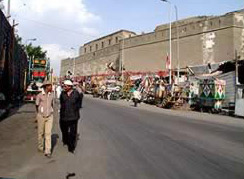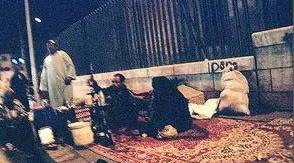El Moulid
By Lara Iskander
"Moulid", meaning birthday in Arabic, is a celebration of a holy person. It is celebrated by Muslims and Christians in Egypt to honor their Saints. Although most Moulids are Muslim, some Coptic Saints are also honored in similar celebrations. From May till October, Coptic Moulids take place from the Nile Delta to Assyut.
Islamic Moulids are regulated by the Lunar Islamic Calendar. The Moulid is not considered to be a proper custom by many Muslims as it is not part of the religion, but rather a popular tradition of the Muslim life.

Light installation for Moulid "Al-Refai". The Arabic text translates as "remember God".

Crowds at the Moulid "Al Refai with a view of the Citadel at the back.
Some of the most notable ones in Egypt are "Moulid El-Naby" (the Prophets birthday) which is the most famous and is celebrated all over the country during the third month of Islamic Calendar, "Rabi al-Awal". Also Moulid "El-Sayyed El-Baddawi" in Tanta is especially popular, attended by over a million people and the Moulid of "Sayyedna El-Hussein" (the prophets grandson) in Cairo celebrated in the Islamic month of "Rabi Al-Tani".
In Egypt, almost every village and every district in the big cities has its Saint and their festivals are celebrated once a year. A very similar aspect to the annual festivities of the local gods feted during the ancient Egyptian times.
Nobody knows exactly when the first celebration of "Moulid Al-Naby" took place but we find it being celebrated during the Fatimid and Ayyubid Era when it was considered a big event attended by Government officials and Muslim spiritual leaders.
The tradition of celebrating the Prophets Birthday also seems very similar to the celebration of Jesus Christs birth, Christmas. Possibly a Christian impact resulting from the years of Crusade waves during which both Islamic and Christian cultures exchanged views and influenced each other in different aspects; Christians brought Sciences and Technologies of the East to Europe and Muslims imitated some of their festivals and feasts.
The Moulid festival spread throughout the Muslim world and is celebrated in many countries, however, some conservative sects consider it to be idolatrous.
Though Muslims in general are aware of Moulid not being a truly Islamic custom, it is still considered a happy occasion where families and friends spend time together and eat good food particularly "Halawet el-Moulid" special sweets offered during Moulid, "hummus" (chick peas) and most of all "Aroussa al Moulid" (candy doll) for the children.

The program of events follows tradition rather than religious obligations. Preparation for the Moulid commences days earlier by the "Mawalidiya" which are groups of people travelling from one Moulid to the other providing the more "social" services, they put up the swings, cafes and booths selling sweets, toys and clothes. Brightly colored tents called "Sowan" housing different Sufi brotherhoods are put up in advance mingling into the concrete housing and ancient architecture. The lighting installments, loud speakers and traders increase daily along with the number of visitors coming from different parts of the country for the special occasion
.


Moulid Lights. Photographed by Yehia Shawkat

The highlight of a Moulid is the "Leila el-Kebira" or the Big Night, the last day of celebration. The Sufis and Sheiks dressed in colorful costumes will be at their most energetic, parading through the streets and performing the "Zikr" (ritual dance); swaying back and forth, moving their bodies and speeding up to the rhythmic beating of a drum and tambourine as the "Munshideen" (singers) perform the devotional chants. Prayers, music and singing from different tents fill the night air till dawn. It quickly fills you with a mysterious air and spirit as you walk through the narrow alleys inviting you to join the celebration.
In order to understand more the real essence of the Moulid or the Sufi practice, the best place to learn is at the event itself. People very willingly will point out a well-known Sheik preaching about this spiritual ritual in a nearby "Sowan" or will simply offer to share their own knowledge.

Crowds gathering around different "sowans" where the rituals take place. (Photographed by Yehia Shawkat)


The Citadel (Photographed by Yehia Shawkat);
Away from the center, more tents are found where people just gather to eat, talk smoke "Shisha"(water pipe), or chant the life and virtues of the Saint while others stand at the sides taking in the music often joining the "Zikr" performance.

Games add entertainment at the Moulid; Right: "Al-Refai" Moulid lights from a nearby rooftop. (Photographed by Yehia Shawkat)

Outside the pushing and shoving increases as the crowds moves restlessly from one "Sowan" to the other. As the crowds get thicker, it becomes more and more difficult to move around and see the different spectacles, to get a full view of a Moulid, the best spot would be the roof of a nearby house or building.
After the Big Night the "Mawalidiya" groups take down their tents and the travelling carnivals move on to the next festival leaving barely any trace of the Moulid that had just taken place the night before.

It is very difficult to know the exact dates of those wandering festivals, as there is no formal list. Visitors rarely get to see the Moulid celebration of the Saints days, but they are well worth tracking down as they offer some of the most distinctive, interesting and ancient spectacles in Egypt.
Some of the most famous Islamic and Coptic Moulids in Egypt and approximate dates:
-
"Moulid el Naby", the prophets Birthday. It is celebrated everywhere.
-
"Sayyida Zeinab" Moulid (The Prophets granddaughter), Held behind the mosque of "Sayyeda Zeinab" where her tomb is. It is one of the most crowded Moulids held during September.
-
Egypt's biggest Moulid is that of "Sayyid Badawi" (Muslim saint), held in Tanta, in the Nile Delta. Usually takes place during October after the crops are sold.
-
"Sayyedna al-Hussein" Moulid held in August in Cairo.
-
"Al-Refai" Moulid at the Citadel Square during September.
-
"Fatma al-Nabawiya" Moulid. Held every July in Darb al-Ahmar district.
-
"Abu al-Hagga al-Uqsuri" Moulid held in Luxor. It takes place in the middle of Islamic month of "Shaaban" and is said to be linked to ancient Egypt.
-
"Moulid al-Adra", The Virgin Marys Moulid is the largest Coptic Moulid held in August at the Monastery of the Holy Virgin in Durunka approximately ten Km from Assyut.
-
"Mari Girgis" Coptic Moulid takes place on the West Bank of the Nile, Luxor during October.
References: First hand account by author.

